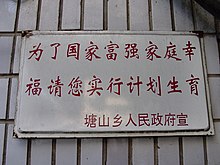
Back سياسات التخطيط الأسري في الصين Arabic Çinin ailə planlaşdırma siyasətləri Azerbaijani Kebijakan keluarga berencana Tiongkok ID 중화인민공화국의 출산 정책 Korean 中华人民共和国计划生育 Chinese 中華人民共和國計劃生育 ZH-CLASSICAL
| Family planning | |||||||||
|---|---|---|---|---|---|---|---|---|---|
 A government sign in Tangshan Village, De'an County, Jiujiang, Jiangxi: "For the sake of the country's prosperity and families' happiness, please implement family planning" | |||||||||
| Traditional Chinese | 計劃生育 | ||||||||
| Simplified Chinese | 计划生育 | ||||||||
| Literal meaning | Planning fertilization | ||||||||
| |||||||||
 |
|---|
|
|
China's family planning policies (Chinese: 计划生育政策) have included specific birth quotas (three-child policy, two-child policy, and the one-child policy) as well as harsh enforcement of such quotas. Together, these elements constitute the population planning program of the People's Republic of China.[1][2] China's program should not be confused with the family planning programs instituted in other countries, which were designed to encourage parents to have the number of children they desired—in China, the provision of contraception through family planning programs was subservient to a birth planning program under which the government designated how many births parents could have in order to control the size of its population.
In Chairman Mao Zedong's time, the Chinese government had an ambiguous and changing attitude toward family planning, especially during the Great Leap Forward.[3][4][5] Family planning was first introduced in the 1950s as a "recommendation," yet had never been strictly implemented until 1970, when the Military Control Commission of China's Ministry of Health announced that contraceptives would be provided free of charge, and Premier Zhou Enlai enacted population growth targets for urban and rural areas, respectively.[6] Malthusian concerns continued, with two-child restrictions starting in the early 1970s under the later-longer-fewer program.[2][3]
After Mao died in 1976, the policy evolved into the one-child policy in 1979, when a group of senior leaders decided that existing birth restrictions were insufficient to cope with what they saw to be an overpopulation crisis.[4][7] But the one-child policy allowed many exceptions and ethnic minorities below 10 million people were exempt.[2]
In late 2015, the remnants of one-child limits were lifted and reverted back to two-child limits as had been in place during the 1970s.[1] And in May 2021, the Xi Jinping Administration formally introduced the three-child policy to replace the two-child policy.[1] After only two months, in July 2021, the government removed all penalties for couples who have as many children as they want.[8]
- ^ a b c Goldman, Russell (2021-05-31). "From One Child to Three: How China's Family Planning Policies Have Evolved". The New York Times. ISSN 0362-4331. Archived from the original on 2023-01-09. Retrieved 2021-06-19.
- ^ a b c Attane, Isabelle (2002). "China's Family Planning Policy: An Overview of Its Past and Future". Studies in Family Planning. 33 (1): 103–113. doi:10.1111/j.1728-4465.2002.00103.x. ISSN 0039-3665. JSTOR 2696336. PMID 11974414. Archived from the original on 2022-10-16. Retrieved 2021-06-19.
- ^ a b Cite error: The named reference
:0was invoked but never defined (see the help page). - ^ a b Fitzpatrick, Laura (2009-07-27). "A Brief History of China's One-Child Policy". Time. ISSN 0040-781X. Archived from the original on 2022-11-11. Retrieved 2021-06-19.
- ^ Cite error: The named reference
:2was invoked but never defined (see the help page). - ^ Scharping, Thomas (2005). Birth control in China, 1949-2000 : population policy and demographic development. London: Routledge. ISBN 9780415386043.
- ^ Zeng, Yi; Hesketh, Therese (2016-10-15). "The effects of China's universal two-child policy". Lancet. 388 (10054): 1930–1938. doi:10.1016/S0140-6736(16)31405-2. ISSN 0140-6736. PMC 5944611. PMID 27751400.
- ^ Cheng, Evelyn (2021-07-21). "China scraps fines, will let families have as many children as they'd like". CNBC. Archived from the original on 2023-01-28. Retrieved 2022-04-29.
© MMXXIII Rich X Search. We shall prevail. All rights reserved. Rich X Search